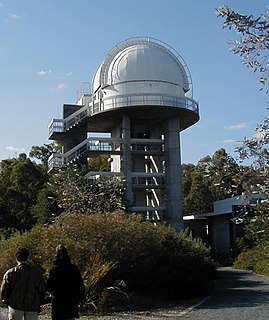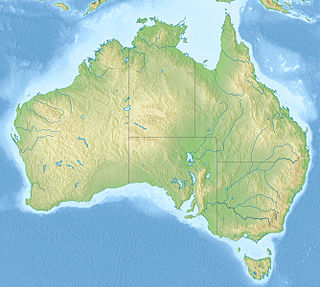
The Apache Point Observatory is an astronomical observatory located in the Sacramento Mountains in Sunspot, New Mexico, United States, approximately 18 miles (29 km) south of Cloudcroft. The observatory is operated by New Mexico State University (NMSU) and owned by the Astrophysical Research Consortium (ARC). Access to the telescopes and buildings is private and restricted.
The Minor Planet Center (MPC) is the official body for observing and reporting on minor planets under the auspices of the International Astronomical Union (IAU). Founded in 1947, it operates at the Smithsonian Astrophysical Observatory.

John Broughton is an Australian amateur astronomer and artist. He is among the most prolific discoverers of minor planets worldwide, credited by the Minor Planet Center with more than a thousand discoveries made between 1997 and 2008. His observations are done at Reedy Creek Observatory, in Queensland, Australia.

Farpoint Observatory is an astronomical observatory owned and operated by the Northeast Kansas Amateur Astronomers' League, or NEKAAL. It is located on the grounds of Mission Valley High School at Eskridge, near Auburn, Kansas, approximately 30 miles (48 km) southwest of Topeka, Kansas, United States.
The Santa Lucia Stroncone Astronomical Observatory is an astronomical observatory located at 350 metres (1,150 ft) altitude in Stroncone, near the city of Terni, in Umbria, north central Italy.

The Perth Observatory is the name of two astronomical observatories located in Western Australia. In 1896 the original observatory was founded in West Perth on Mount Eliza overlooking the city of Perth. Due to the city's expansion the observatory moved to Bickley in 1965. The new Perth Observatory is sometimes referred to as Bickley Observatory.

The Badlands Observatory (IAU code 918) is an astronomical observatory named after the Badlands National Park, located in Quinn, South Dakota, near the city of Wall, United States. The observatory was founded in 2000. by American amateur astronomer Ron Dyvig, who was associated with the Optical Sciences Center and Steward Observatory of the University of Arizona. While there, he occasionally participated in observing runs using the telescopes on Kitt Peak. Kitt Peak Observatory As of November 2016, a total of 25 numbered minor planets were discovered at the observatory. The Minor Planet Center credits these discoveries to Ron Dyvig and to the observatory, respectively. The main-belt asteroid (315495) 2008 AQ3 was discovered by Italian amateur astronomer Fabrizio Tozzi while using the Badlands Observatory telescope remotely via the Internet in 2008. Asteroid 26715 South Dakota, discovered by Ron Dyvig in 2001, is named after the U.S. state South Dakota, where the Badlands observatory is located.

Highland Road Park Observatory or Baton Rouge Observatory is an astronomical observatory jointly operated by Louisiana State University's astronomy department, Baton Rouge Astronomical Society, and The Recreation & Park Commission for the Parish of East Baton Rouge. It is in Baton Rouge, in the U.S. state of Louisiana, in Highland Road Park.

Desert Eagle Observatory is a private amateur astronomical observatory, situated near Benson, Arizona, United States. Operated by Canadian amateur astronomer William Kwong Yu Yeung, the observatory's primary purpose is the observation and discovery of comets and minor planets, which include asteroids and near-Earth objects. At the observatory, Bill Yeung has discovered more than 1,500 minor planets.

The Piszkéstető Station or Piszkéstető Mountain Station is an astronomical observatory in Mátraszentimre in Mátra Mountains, about 80 kilometers (50 mi) northeast of Hungary's capital Budapest. It is a station of Konkoly Observatory, first built in 1958. It has the observatory code 461 and 561 for being used by the Szeged University and Konkoly Observatory, respectively.
Mount Lemmon Survey (MLS) is a part of the Catalina Sky Survey with observatory code G96. MLS uses a 1.52 m (60 in) cassegrain reflector telescope operated by the Steward Observatory at Mount Lemmon Observatory, which is located at 2,791 meters (9,157 ft) in the Santa Catalina Mountains northeast of Tucson, Arizona.

Grove Creek Observatory is an astronomical observatory in Trunkey Creek, New South Wales, Australia. It has some of the darkest night skies and best seeing conditions of any observatory in Australia. The site also hosts remote-controlled telescopes in three separate enclosings. It is located about 4 hours drive from Sydney, Australia. It is run by Jim Lynch and Greg Ford.
15092 Beegees, provisional designation 1999 EH5, is a stony Eoan asteroid from the outer regions of the asteroid belt, approximately 12 kilometers (7.5 miles) in diameter. It was discovered on 15 March 1999, by Australian amateur astronomer John Broughton at his Reedy Creek Observatory in Queensland, Australia. The S-type asteroid was named for the brothers of the Gibb family, known as the musical trio Bee Gees.

Bagnall Beach Observatory (obs. code: 433) is a privately owned astronomical observatory by Greg Crawford, located in Corlette, New South Wales, on the east coast of Australia. The observatory has discovered 3 minor planets:

Oakley Observatory or Rose–Hulman Observatory is an astronomical observatory operated by Rose–Hulman Institute of Technology in Terre Haute, Indiana, United States.

The Remote Astronomical Society (RAS) Observatory, Mayhill, also known as the New Mexico Skies Observatory is a remotely controlled observatory hosted by the New Mexico Skies astronomy hosting company.

Astrodomi observatory is an astronomical observatory located in Tigre, Buenos Aires Province, Argentina. It has observatory code I37.
The Edgar Wilson Award is an annual international award established in 1998 consisting of a monetary award and a plaque allocated annually to amateur comet discoverers. It is administered by the Smithsonian Astrophysical Observatory (SAO) through the IAU's Central Bureau for Astronomical Telegrams (CBAT).

The Sormano Astronomical Observatory is an astronomical observatory north of Milan, Italy. Located near the Swiss border at 1000 meters altitude at the mountain village of Sormano in the pre-Alps, the observatory was privately funded by the Gruppo Astrofili Brianza and built in 1986.
Observations of minor planets as well as comets and natural satellites of the Solar System are made by astronomical observatories all over the world and reported to the Minor Planet Center (MPC), a service of the International Astronomical Union. The MPC maintains a data base that stores all observations submitted by these registered observatories. An astrometric record consists of the position, brightness and timestamp of an observed object, besides additional information. The database contains more than 200 million records gathered over the past two centuries.











